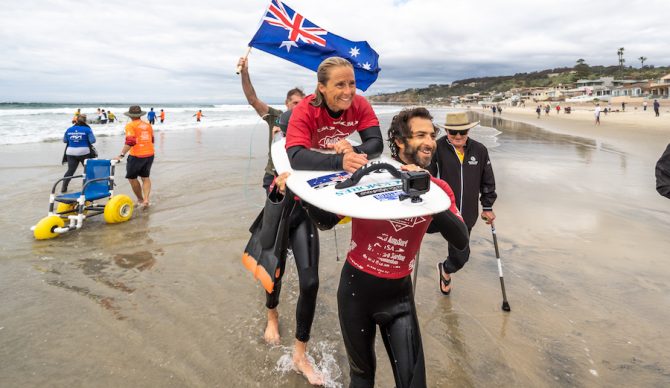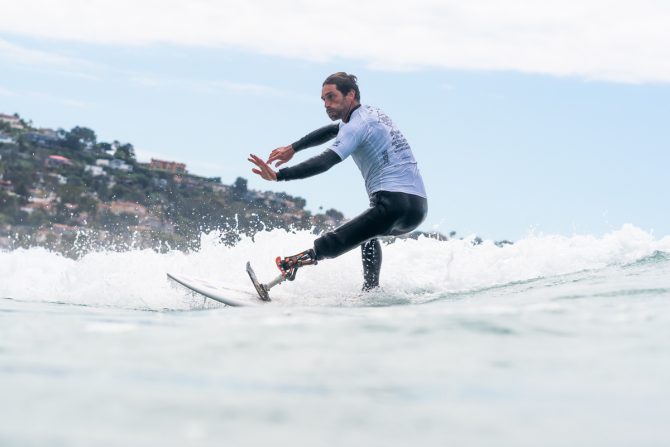
Last year, Team Spain rode a pair of visually impaired gold medals to a historic first team title. Photo: ISA/Pablo Jimenez
Editor’s Note: This piece is brought to you by our partners at the ISA.
Starting this Monday December 6 through Saturday December 11, the sixth World Para Surfing Championships (WPSC) will take place in Pismo Beach, California. Para Surfing is one of the fastest-growing parts of the surf world today. The International Surfing Association (ISA) has hosted the WPSC since 2015, and the 2020 AmpSurf ISA WPSC was the most successful and well-attended edition to date, nearly doubling in size from 69 athletes in 2015 to 131 in 2020. And following the success of the Olympic debut of surfing at Tokyo 2020, Para Surfing has its sights set on inclusion in the 2028 Paralympic Games in Los Angeles.
To get you ready for the action, we thought we’d give you a run-down of some of the event’s key aspects as well as a few stories of top-level athletes to follow.

Brazilian Alcino Neto is definitely a competitor to keep an eye on next week. Photo: ISA/Pablo Jimenez.
This year, Pismo is set to welcome para surf athletes from at least 26 countries with El Salvador, Jamaica, and Puerto Rico joining for the first time. Team USA and Team Spain are the favorites for the World Team Championship Gold Medal at this year’s event, both coming with a full or nearly full roster. Brazil, Hawaii and Costa Rica are also top competitive teams, likely to give the top two a run for their money. At the 2020 event last year, Team Spain took home the gold, Team USA took silver and Brazil came away with the bronze.
Para Surfing Classification
Para Surfing Classifications are important to understand for spectators, both at the event and for those of us following along online. They’re a massive step forward for para surfing, allowing athletes to be judged fairly and to compete on an equal playing field with those of similar ability. Athletes compete in nine different categories – seven based on physical impairment and two based on visual impairment.
Para Surfing Stand 1, 2, and 3 take athletes capable of riding waves in a standing position. Para Surfing Kneel takes surfers who ride waves kneeling or sitting without use of a paddle. Para Surfing Sit is for surfers who ride in a seated position, use a paddle and are self sufficient when it comes to paddling into waves and getting back on their board in a safe manner. Para Surfing Prone 1 and 2 are for athletes who ride waves in a prone position, the difference being whether or not they need assistance paddling into waves and getting back on their boards in a safe manner. Para Surfing Visually Impaired 1 and 2 is for surfers who are visually impaired to varying degrees. The full rundown of classification specifics can be found on the ISA website.
Stories to Watch
This is by no means an exhaustive list, as there are plenty of exciting athletes to watch at the event such as Dariel Melendez of Costa Rica who wowed the internet with his one-legged surfing technique. People rallied to help Dariel purchase a prosthetic leg, and he’ll be competing this year in the Para Surfing Stand 2 division. Here are some other athletes we’re watching this year.
Liv Stone (USA) – Para Surf Stand 1
Liv Stone was born with a congenital limb difference, having shorter arms with two fingers on each hand, but that has never stopped her from living an active lifestyle or competing at a high level, playing varsity soccer her freshman year of high school. Even so, growing up in Pennsylvania didn’t provide many opportunities for surfing until 2017 when Liv attended one of Bethany Hamilton’s Beautifully Flawed Retreats. It’s there she was introduced to surfing, and since then she hasn’t stopped.
In 2019 her family moved to Carlsbad, California to be closer to the ocean, and last year Liv won her first gold medal at the 2020 ISA World Para Surfing Championships. This year could see her gain her second gold if she’s able to best the other ladies in the highly competitive field of Para Surfing Stand 1 athletes.

Sam at the 2020 WPSC. Photo: Sean Evans.
Sam Bloom (Australia) – Para Surf Prone 2
Sam Bloom didn’t grow up in a wheelchair. The Australian mother-of-three had everything going for her in life. A surfer, she had traveled the world, attained her lifelong dream of becoming a nurse, and raised three sons with her husband Cameron. Then in 2013, Sam fell through a rotten hotel balcony railing while on vacation in Thailand, an accident which left her paralyzed from the chest down and in search of a meaning in her life.
Her recovery, recounted in the 2020 Netflix film Penguin Bloom, was instigated by an injured Australian Magpie chick which the family took in and named Penguin. The injured bird helped Sam rediscover meaning in her life, and soon enough Sam was back in the water through competitive paracanoeing, taking two Australian titles and placing 13th in the world. She rediscovered surfing, was selected for the Australian Para Surf Team in 2018 and won gold at the 2019 and 2020 World Para Surfing Championships in the Para Surf Prone 2 division.

Matt surfs almost completely by feel, but the only thing that might alert you to that fact are the words “Blind Surfer” printed on his wetsuit. Photo: mattformston.com
Matt Formston (Australia) – Para Surf Visually Impaired 2
Matt Formston has been a professional athlete for over a decade. He got his start in paracycling, taking gold and silver at the 2014 and 2015 UCI Paracycling Track World Championships as well as setting a world record in the Tandem Pursuit event in 2014. Matt represented Australia at the 2016 Rio Paralympics, but soon moved on from cycling to pursue his great love for surfing at the professional level. With only five percent of his vision, Matt surfs almost completely by feel, but if you were to watch him surf the only thing that might alert you to that fact are the words “Blind Surfer” printed on his wetsuit. The man shreds.
He’s currently the reigning world champ in the Para Surfing Visually Impaired 2 division after winning gold at the 2017, 2018, and 2020 World Parasurfing Championships. Will he be able to defend his title against hopefuls such as Figue Diel of Brazil, who’s been hot on his heels with silver medals in the past couple years? We’ll have to wait and see.

Natalia at the fourth ISA WPSC. Photo: ISA/Sean Evans
Natalia Vindas (Costa Rica) – Para Surf Prone 1
Para surfing is at the center of Natalia Vindas’ life. “It is passion, motivation, joy, peace… Every time I go surfing I feel so small before the immensity and force of the sea … but at the same time so great to face my fears, fall, get back up and catch those waves.”
In her day job, Natalia works on developing accessible tourism in her home country of Costa Rica and abroad, and gives trainings, talks and interviews on creating accessible spaces with her background in civil engineering and creating accessible tourism opportunities for those with disabilities. She will definitely be an athlete to watch this year as she competes for her first gold medal in the Para Surf Prone 1 division.

Eric, at last year’s WPSC. Photo: ISA/Sean Evans
Eric Dargent (France) – Para Surfing Stand 3
Eric Dargent was surfing in the Indian Ocean off of Réunion Island when he was attacked by a shark and lost his left leg above the knee as a result.
The attack did nothing to damage Eric’s love of surfing, and he went so far as to develop an action sports-oriented prosthetic knee with snowboarding amputee Patrice Barattero and help from an orthopedic surgeon to help get him back in the water. The prosthetic, marketed and produced as the Easy Ride sports knee by French company Proteor, is resistant to seawater, low temperatures, and incorporates a hydraulic shock absorber that is used in mountain bikes. It helped Eric win a silver medal in the Para Surfing Stand 3 division last year, and you’ll be able to see Eric sporting his creation as he goes for gold at Pismo Beach this year.
If you can’t make it to Pismo Beach for the event, be sure to tune in for the World Para Surfing Championships online at ISAsurf.org starting Monday, December 6.

